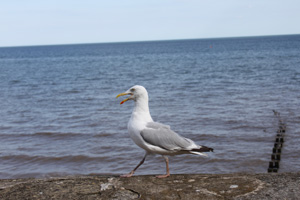
Screenings:
Friday
Works by Steina and Woody Vasulka
Steina and Woody Vasulka are pioneers of the screening of video art and the development of digital arts. These screenings highlight some of their work and complement the talk that they gave at Bournemouth University earlier in 2010.
Artifacts - 'This videotape spotlights the research that Woody Vasulka has conducted since
the mid-1970s to generate electronic images without camera support. Though Artifacts (1980)
arises from a pragmatic relationship with technology, the work nonetheless remains a playful
discovery of a new visual language. Artifacts is the second part of the series Syntax of
Binary Images, which also includes Transformations (1978). The work provides an overview of
the effects created by digital-analogue digitizers of the time. Here, Woody relies especially
on the Digital Images Articulator (also called Imager), which he co-designed with
Jeffrey Schier.' - Fondation Langlois
Running Time: 22 minutes
Summer Salt - Summer Salt is a dramatic exploration of the phenomenology of space and vision,
as Steina uses mechanical and electronic devices to physically investigate the southwestern landscape.
The artificial vision allows the viewer altered perceptions and spatial perspectives. The five
segments include dynamic exercises with Steina's mirrored lens attachment, the physicality of
unexpected camera placement, and electronic manipulation of the textures and colors of the landscape.
Running Time: 18 minutes
Friday, Saturday and Sunday (see programme for timings) Made in Bournemouth Works by students of Bournemouth University and Arts University College Bournemouth - A programme of works showing the best from the internationally renowned animation courses at National Centre for Computer Animation, Bournemouth University, & Arts University College, Bournemouth. Curated by Skillset, Bournemouth Screen and Media Academy and SCAN. Running Time: 1 hour (approx)
Coastcards -
Three short films commissioned by Animate Projects as part of the Sea Change initiative. Susan Collins, has sent a coastcard from Bridlington, East Yorkshire; Andrew Kötting, has sent a coastcard from Hastings, East Sussex; and Kayla Parker & Stuart Moore have sent a coastcard from Teignmouth, Devon.
Each celebrates the heritage of England's seaside resorts and explores the unexpectedness of the seaside by presenting a film that responds to a coastal town that the artists live in or nearby. Running Time: 10 minutes approx
Motion Frames - intimate mini sketches of seaside promenaders, by Louise Pack
People promenading on Bournemouth seafront, on a hot summer’s day, were invited to present
themselves to camera, with no direction or supervision, in a style reminiscent of Andy Warhol’s
film portraits. Sitting behind the frame, participants are isolated from the everyday and free
to express their thoughts alone, without mediation. This piece reflects the artist’s interest
in how the placement of a camera effects certain situations.
Running Time: 3 mins approx
The Pleasure of Gliding, by Jane Mason and Becky Edmunds
A charming recollection of stories and emotions about the power of dancing. Choreographer Jane Mason
and film-maker Becky Edmunds created The Pleasure of Gliding through a series of interviews and workshops,
which explored people’s memories and love of dancing in Bournemouth Pavilion. The Pleasure of Gliding
was commissioned by Dance South West to mark the transformation and regeneration of a disused part of
Bournemouth Pavilion into the new dance centre Pavilion Dance.
Running Time: 10 minutes
ZeitEYE, Bob Cotton
ZeitEYE is a film about innovation in the arts and media since 1900. In an 11 minute montage it relates the back-story of our current high-band multi-media environment. The last eleven decades have seen the invention of a wide range of techniques and technologies, and a number of key ideas, that have together modulated the development of media and created our contemporary globally networked, digital media-space. These include: animation, special effects, Cinema, Cubism, radio broadcasting, Futurism, mass-colour-photography, colour half-tone printing, DADA, Surrealism, television, computing, global telephone networks, Asimov’s I Robot, satellite communications, The MIT Media Lab, multi-spectral scanning, Cybernetics, holography, laser, cellular networks, WWW, server-push, Web 2.0, messaging, HD, Age of Intelligent Machines, digital film-making, Simulacra and Simulation, and a whole lot more. ZeitEYE provides a chronological overview of these developments from the perspective of 2010. Running Time: 11 Minutes
Sunday
Little Lupin, Luci Gorell Barnes
The Tragic and Disturbing Tale of Little Lupin. With its roots in the rich, dark soil of fairy tales, it tells the story of a girl who is not like others and of how life in the woods can take unexpected turns. Little Lupin is a hand drawn animation made by Luci Gorell Barnes accompanied by an original score written and performed by Richard Hughes. The film is narrated by Ali Hughes. Running Time: 11 minutes
General Release Films
WALL-E (U)
One of Pixar’s best animations from 2008, set in a distant, but not so unrealistic future, where mankind has
abandoned earth because it has become covered with trash from products sold by the powerful multi-national
Buy N Large corporation. WALL-E, a garbage collecting robot has been left to clean up the mess.
One day he meets Eve, a sleek (and dangerous) reconnaissance robot who is sent to find proof that life is
once again sustainable and the film follows their adventures.
Running Time: 1h 37m
Where the Wild Things Are (PG)
Based on the classic story by Maurice Sendak, this film charmingly retells the story in film. Max has an
active imagination, and he will throw fits if others don't go along with what he wants. Following a series
of incidents at home, Max runs away wearing his wolf costume toward a world in his imagination. This world,
an ocean away, is inhabited by large wild beasts, including one named Carol who is much like Max himself
in temperament. Instead of eating Max like they normally would with creatures of his type, the wild things
befriend Max after he proclaims himself a king who can magically solve all their problems.
Running Time: 1h 34m
Forbidden Planet (U)
A major cult science fiction film from the 1950s with sumptuous sets and groundbreaking special effects
the storyline is based loosely on Shakespeare’s The Tempest. An Earth mission arrives on Altair IV,
a planet that Dr. Edward Morbius and his beautiful daughter Altaira are the only survivors from the original
expedition that had arrived some 20 years before. Morbius discourages them from landing their spaceship
and tries to get them to leave but Commander Abrams and his men soon face an invisible force leading them
to believe that Morbius and the girl are in danger.
Running Time: 1h 35m